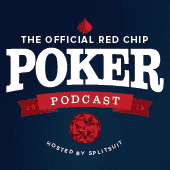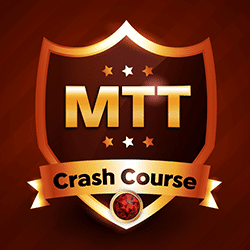Luke Haward is the newest coach at Red Chip Poker, and in this episode we interview him about overhauling our MTT games. We focus on pre-flop leak-busting, the subject of Haward’s debut Red Chip PRO video, but the discussion reaches wide and far into subjects like staking, ICM, leveraging stack sizes, bubble and final table dynamics, and more. It’s a must-listen for any MTT player.

Introduction
Haward discusses his introduction to poker during the Moneymaker days, and how he studied hard and found a group of fantastic poker peers to become an in-demand MTT coach. His teaching background includes philosophy, critical thinking, and other subjects. Starting in 2010 he began managing his bankroll, study more, and joined up with online poker communities to improve. Other highlights include being coached and backed by Fedor Holz, perhaps the most famous and accomplished tournament player of our day.
Staking
Haward is both a staker and a stakee at Evolve Staking. He explains that to be staked, you need some sort of proven results across a reasonable sample size, and references from the poker community or even the professional world.
He believes over half of the high-stakes MTT grinders are staked.
Static Ranges
Haward talks about static ranges, and how they can be the bane of a tournament player’s existence. It’s a common leak seen in many beginning players. If you’re static with your range with regard to position or stack depth, you are making a mistake.
He says to look out for spewy fish and LAGs to exploit, but the more common fish to target are those that play to tight and nitty.
Aggression in MTTs
Following from the idea of static ranges being a huge leak, too many players are sticking too close to ABC poker. Haward suggests in early stages opening a bit wider, especially if you’re deep enough, and maintain pot control to avoid playing too big at the start. You’ll very often go heads-up to the flop and be given credit for holding a good hand. This puts you in an advantage position that allows you to play hole cards like 76s, because the implied odds of hitting your hand will edge your equity further toward profitability.
Always look to gather as much information as possible. Obviously, your HUD online is your main source of information, but with many unknowns you’ll often be readless with a small sample size. Haward suggests making assumptions based on the population and then target those predicted tendencies for exploitation.
If you keep your eyes peeled, you can sometimes pick up some information that you can use on the following hand, you don’t need to wait to build up a relevant sample size.
Taking Shots
If Haward was giving advice on what shot to take, he’d recommend a soft $215. You’ll still encounter a good amount of fish, and the sample sizes you get on hand histories will still be relevant as higher stakes players often grind lower stakes tournaments these days. Competent TAGs and LAGs are more abundant at these levels. Some of his tips for handling these players: You’re going to need to defend your big blind more correctly, make sure you’re not playing fit-or-fold and pay closer attention to ranges.
By taking shots at the higher buy-in tournaments, you will develop important skills in regards to how to counter better players, becoming a better player in the process.
Related Podcast
Spotting Live Poker Pros
Bubble Play
Stack size is what players should be focused on when approaching the bubble, he says. If you’re a short stack, you really do need to tighten up and play solid push/fold poker. Bigger stacks can leverage the fear of bubbling to their advantage by dialing up the aggression.
He sees a lot of beginner MTT players be too nitty and overvalue not getting in their stacks. This pressure that novices put on themselves to get in the money often results in -EV plays out of fear of losing one’s tournament life.
Also, Haward says it’s important to remember that you can bet/fold or flat in spots where you might default to push/fold. You don’t always have to put your stack at risk to put pressure on other players.
Independent Chip Model
Haward gives a great overview of the independent chip model, known to most as ICM. This is a way to determine the value of your tournament chips in relation to the prize pool and the number of players left. As you go deeper in the tournament, ICM becomes more and more of a critical factor. Unlike in cash games, in tournaments the value of the chips changes based on where you are in terms of the prize distribution. Especially at the final table, the value of your chips will change dramatically.
“Your last chip in your stack is your most valuable one,” Haward reminds listeners. Losing 30,000 in chips vs. winning 30,000 in chips can be a huge difference depending on ICM. If the pay jump is significant
Stealing in Tournaments
Targeting opponents with custom-tuned exploitative strategies is key to stealing in tournament. Realize you can steal vs. nitty players in the blind with almost any two cards, but be more careful with your range vs. trickier opponents. In the latter scenario, stack sizes and post-flop equity matter a lot more, because you are going to get flatted and raised/shoved on more often. Against good players (who use the advice Haward just gave), you need to balance your opens that you’re willing to call off with, and make sure to balance your bet/fold hands. Versus weaker players, you can steal exploitatively wide.
GTO vs. Exploitative Play
Haward recommends that players who are just starting out with their MTT study should focus on exploitative play even more than game theory optimal play. It’s where you can build a bigger edge in a shorter amount of time. Certainly, GTO is worth knowing inside and out, but Haward sees many players who try to apply GTO to fish and weaker tournament lose profitability. GTO is mainly for higher stakes where play is highly evolved. Low stakes is much more of an exploitative game. Approaching mid stakes, Haward sees more of a need for basic GTO knowledge. It’s only when you move up from the mid-stakes where you’re likely to need to be a GTO expert to compete at the highest level.
Poker Software for MTT Study
Haward recommends the following poker software as a good start for players just getting into off-table study with apps:
HUD – PokerTracker 4 & Hold ‘Em Manager 2
Away from table study – Hold ‘Em Resources Calculator & ICMizer
Starting point – Flopzilla
Haward’s Coaching
Haward closes out the podcast with a little more strategy and runs down his coaching approach. He has day-to-day Skype hand reviews and packages of hours at lower rates. He’s also started doing weekly groups to offer coaching at a lower price point. You can contact him at his Bink Big website if you’re interested in receiving a free Skype consultation to see if he can help you up your MTT game.

